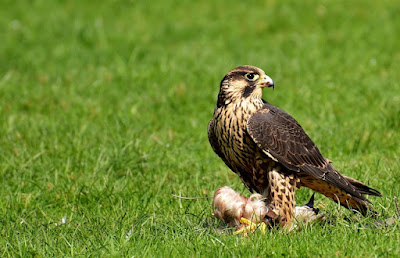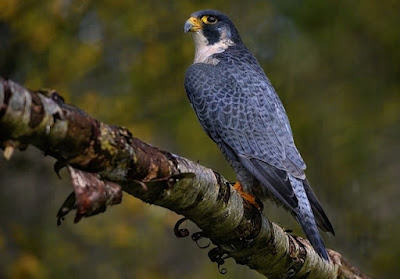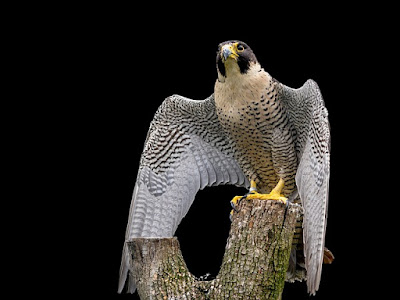The Peregrine Falcon, scientifically known as Falco peregrinus, is a marvel of nature's design, a symbol of grace and precision. Revered as one of the world's most majestic raptors, this remarkable bird of prey has fascinated humans for centuries. From its awe-inspiring aerial acrobatics to its breathtaking hunting skills, the peregrine falcon stands as a testament to the beauty and power of the natural world. In this article, we will explore the remarkable characteristics and life of the Peregrine Falcon.
Distribution and habitat
Peregrine falcons are one of the most widespread birds of prey on the planet, found on every continent except Antarctica. Their distribution is remarkable, as they are as at home in urban environments as they are in remote wooded areas. These adaptable raptors have managed to thrive in a variety of habitats including coastal cliffs, mountainous areas and even skyscrapers in major cities.
Physical characteristics
Peregrine Falcons are famous for their attractive appearance. They are medium-sized birds with a wingspan of 95–120 centimeters (37–47 in) and a body length of 34–58 centimeters (13–23 in). These birds exhibit sexual dimorphism, with females generally being larger and heavier than males. Adult peregrine falcons have distinctive blue-grey feathers on their upperparts and white with black bars on their underparts. Their striking black markings on the white chest and their dark eyes make them easily recognizable.
Aerodynamic Miracle
Peregrine falcons are renowned for their unparalleled speed and agility in the air. They are often considered the fastest animals on Earth, reaching speeds of up to 240 mph (386 kph) while hunting or during high-speed dives. This incredible speed is achieved through their streamlined body shape, strong muscles and special adaptations such as narrow, pointed wings and stiff tails.
Hunting techniques
Peregrine falcons are formidable hunters, preying on pigeons, ducks and other birds such as songbirds. They use a hunting technique called stoop, during which they drop from great heights, landing on their prey with amazing speed and accuracy. In the final moments of stopping, the falcon holds its wings close to its body to reduce wind resistance and uses its sharp talons to catch the prey in mid-air. This precise and high-speed maneuvering makes the peregrine falcon an apex predator in the bird kingdom.
Behavior and reproduction
Peregrine falcons are known for their territorial behavior. They establish territories during the breeding season and defend them fiercely. Nests are often located on cliffs, ledges or man-made structures, including buildings and bridges. These birds are monogamous, with pairs forming long-term bonds.
Peregrine falcons lay a large clutch of eggs each year, usually 2-5 eggs. The incubation period lasts about 29–32 days, with both parents sharing the responsibility of keeping the eggs warm. Once hatched from the eggs, the chicks, called issies, depend on their parents for food and protection. The young hawks fledge and become independent after about 42–46 days.
Conservation status
The peregrine falcon has faced significant challenges, primarily due to the harmful effects of pesticides such as DDT, which caused eggshell thinning and breeding failure in the mid-20th century. However, due to conservation efforts and bans on these pesticides in many countries, the peregrine falcon has made a remarkable recovery. It is no longer classified as endangered in most areas and serves as evidence of the power of environmental management.
The Peregrine Falcon is a symbol of the perfection of nature and a symbol of grace, strength and precision. With its astonishing speed and acrobatics, striking appearance and remarkable adaptability, it has captured the imaginations of bird lovers and scientists alike. As an integral part of ecosystems around the world, the Peregrine Falcon inspires awe and appreciation for the natural world, reminding us of the importance of protecting our environment and the incredible creatures that call it home.
Here are some interesting facts about the Peregrine Falcon:
- Speed Demon: The Peregrine Falcon is known as the fastest animal on the planet. They can reach speeds of up to 240 mph (386 kph) while diving or swooping at high speed, making them formidable hunters.
- Global distribution: Peregrine falcons have a remarkable global distribution, being found on every continent except Antarctica. They are highly adaptable and can thrive in a variety of habitats, from cliffs and mountains to urban skyscrapers.
- Stealthy hunters: These birds of prey are skilled hunters, adept at catching other birds in the air. They use their incredible speed and accuracy to ambush their prey, and use their sharp claws to secure their catch.
- Striking Plumage: Peregrine Falcons have a distinctive blue-grey plumage on their uppersides and white with black bars on their undersides. Their black markings on the white chest and their dark eyes make them easily recognizable.
- Territorial behavior: During the breeding season, peregrine falcons establish territories and defend them fiercely. These areas are often located in high and inaccessible places such as cliffs or tall buildings.
- Monogamous Birds: Peregrine falcons are known to form monogamous pairs. These bonds are long-lasting, with mates often staying together for several breeding seasons.
- Nesting sites: They build their nests on cliffs, ledges, and man-made structures such as buildings and bridges, called irises. The choice of nesting sites varies depending on the availability of suitable sites.
- Successful recovery: Peregrine falcons suffered significant declines in the mid-20th century due to the use of the pesticide DDT, which caused thinning eggshells and reproductive failure. However, due to conservation efforts and the ban on DDT in many areas, they have recovered significantly and are no longer considered endangered in most areas.
- Vocal: Peregrine falcons are not particularly vocal, but they communicate with each other through a variety of calls, including high-pitched screams and chattering sounds during courtship and territorial disputes.
- Exceptional vision: Their keen vision is essential for detecting prey from height. Peregrine falcons have special adaptations to their eyes, including a small pit in the fovea that enhances their ability to track fast-moving objects.
- Impressive migration: Some peregrine falcons are migratory, covering long distances between their breeding and winter habitats. They can cover distances of thousands of miles during these seasonal migrations.
- Conservation success: The recovery of the peregrine falcon is considered one of the most successful conservation stories of the 20th century. The resurgence of their population reflects the positive impact of environmental conservation efforts.




Comments
Post a Comment